Module 6 A Teach Plan for Unit 2 Poems
高中英语:Module 6 Teaching Plan教案外研版必修3
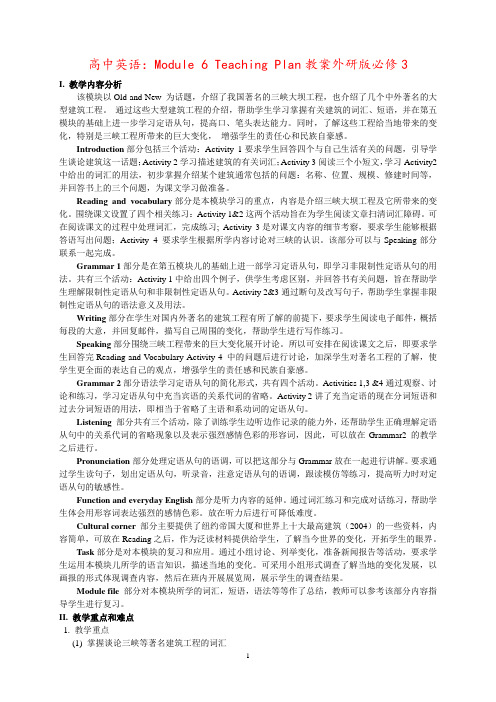
高中英语:Module 6 Teaching Plan教案外研版必修3I. 教学内容分析该模块以Old and New 为话题,介绍了我国著名的三峡大坝工程,也介绍了几个中外著名的大型建筑工程。
通过这些大型建筑工程的介绍,帮助学生学习掌握有关建筑的词汇、短语,并在第五模块的基础上进一步学习定语从句,提高口、笔头表达能力。
同时,了解这些工程给当地带来的变化,特别是三峡工程所带来的巨大变化,增强学生的责任心和民族自豪感。
Introduction部分包括三个活动:Activity 1要求学生回答四个与自己生活有关的问题,引导学生谈论建筑这一话题;Activity 2学习描述建筑的有关词汇;Activity 3阅读三个小短文,学习Activity2中给出的词汇的用法,初步掌握介绍某个建筑通常包括的问题:名称、位置、规模、修建时间等,并回答书上的三个问题,为课文学习做准备。
Reading and vocabulary部分是本模块学习的重点,内容是介绍三峡大坝工程及它所带来的变化。
围绕课文设置了四个相关练习:Activity 1&2这两个活动旨在为学生阅读文章扫清词汇障碍。
可在阅读课文的过程中处理词汇,完成练习; Activity 3是对课文内容的细节考察,要求学生能够根据答语写出问题;Activity 4 要求学生根据所学内容讨论对三峡的认识。
该部分可以与Speaking部分联系一起完成。
Grammar 1部分是在第五模块儿的基础上进一部学习定语从句,即学习非限制性定语从句的用法。
共有三个活动:Activity 1中给出四个例子,供学生考虑区别,并回答书有关问题,旨在帮助学生理解限制性定语从句和非限制性定语从句。
Activity 2&3通过断句及改写句子,帮助学生掌握非限制性定语从句的语法意义及用法。
Writing部分在学生对国内外著名的建筑工程有所了解的前提下,要求学生阅读电子邮件,概括每段的大意,并回复邮件,描写自己周围的变化,帮助学生进行写作练习。
teaching plan of unit 1 module 6
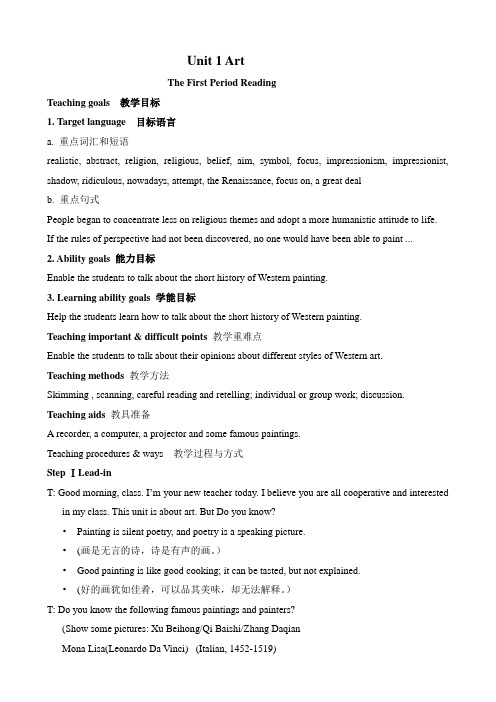
Unit 1 ArtThe First Period ReadingTeaching goals 教学目标1. Target language 目标语言a. 重点词汇和短语realistic, abstract, religion, religious, belief, aim, symbol, focus, impressionism, impressionist, shadow, ridiculous, nowadays, attempt, the Renaissance, focus on, a great dealb. 重点句式People began to concentrate less on religious themes and adopt a more humanistic attitude to life.If the rules of perspective had not been discovered, no one would have been able to paint ...2. Ability goals 能力目标Enable the students to talk about the short history of Western painting.3. Learning ability goals 学能目标Help the students learn how to talk about the short history of Western painting.Teaching important & difficult points教学重难点Enable the students to talk about their opinions about different styles of Western art.Teaching methods 教学方法Skimming , scanning, careful reading and retelling; individual or group work; discussion. Teaching aids教具准备A recorder, a computer, a projector and some famous paintings.Teaching procedures & ways 教学过程与方式Step ⅠLead-inT: Good morning, class. I’m your new teacher today. I believe you are all cooperative and interested in my class. This unit is about art. But Do you know?•Painting is silent poetry, and poetry is a speaking picture.•(画是无言的诗,诗是有声的画。
A teaching plan for Unit1, Module6(外研版七年级英语下册教案教学设

一、 Teaching materials:Unit1 Cycling is more dangerous than swimming.(Module6 The Olympic adventure)二、 Targets for this period:To understand conversations about sportsTo process information of comparison concerning sportsTo talk about the sports one likes using comparative forms三、Key points:Key vocabulary--basketball, cycling, gymnastics, running, skiing, table tennis, dangerous, safe, difficult, easy, exciting, boring, expensive, cheap, popular, relaxingKey structures –more…than…四、Teaching methods:Task-based approach and interactive approach五、Teaching aidsTape recorder, video, OHP, supplementary exercises六、Teaching arrangements:Step One Revision 根据提示完成句子。
1. Beijing/ Cambridge / big (Beijing is bigger than Cambridge.)2. An elephant /a monkey /strong (An elephant is stronger than a monkey.)3. Hong Kong / Dalian / busy (Hong Kong is busier than Dalian.)4. London / Shanghai / cool / in summer (London is cooler than Shanghai in summer.)5. Hong Kong / Beijing/ hot/ in summer? (Is Hong Kong hotter than Beijing in summer?)6. Chang Jiang /the River Thames /wide? (Is Chang Jiang wider than the River Thames?)Step Two New words and expressions learning1. Students read after the tape2. To correct some pronunciationsStep Three Language points1. excite ------ exciting ------ excitedtire ------ tiring ------ tiredbore ------ boring ------ boredrelax ------ relaxing ------ relaxedinterest ------ interesting ------ interested(v.) (使)… (adj.)令人/使人…(修饰物) (adj.)(感到)…(修饰人)eg. The news is really exciting , and everyone is excited . (excite)2. more (many/much的比较级)3. danger(n.) out of danger 脱离危险in danger (of) 处于(…)危险中4. go skiing 去滑雪5. be popular with 受…欢迎6. safety (n.)Step Four To describe the pictures with the given words (Activity Two) Gymnastics ---- difficult Gymnastics is difficult. (Picture a-3) Table tennis ---- popular Table tennis is popular. (Picture b-1) Basketball ------ exciting Basketball is exciting. (Picture c---2) Running ------ cheap Running is cheap. (Picture d---5)Cycling ---- tiring Cycling is tiring. (Picture e---4)Skiing ---- dangerous Skiing is dangerous. (Picture f--- 6)Step Five Opposite opinions learning1. To remember the words quickly正反popular 流行的 unpopular 不流行的difficult 难的 easy 容易的cheap 便宜的 expensive 昂贵的exciting 激动人心的 boring 乏味的tiring 累人的 relaxing 令人放松的dangerous 危险的 safe 安全的2. To match the words in Box1 with the opposite words in Box2. (Activity three)3. To listen and repeat the sentences in Activities2 and 3. (Activity Six)Step Six Listening and reading1. Students answer the questions before listening.1). What do you know about Olympic sport?2). What sports are we Chinese good at? (We are good at gymnastics and table tennis.)3). What Olympic sport do you like? Why?2. Students listen and check the true sentences. (Activity Four)1). Chinese people are good at gymnastics, but we aren’t good at table tennis. (×)2). Daming thinks that table tennis is more popular than gymnastics. (√)3). Betty’s favourite sport is basketball. (×)4). Daming thinks that ru nning is more boring than basketball. (×)5). Betty thinks that skiing is more dangerous than running and cycling. (√)3. Students listen again and check the sports they like. (Activity five)Gymnastics Basketball Running CyclingDaming √ √ √Betty √ √4. Language Points1). Chinese people are very good at gymnastics. 中国人非常擅长体操。
Teaching plan of Unit6单元复习教案 新课标 人教版 教案
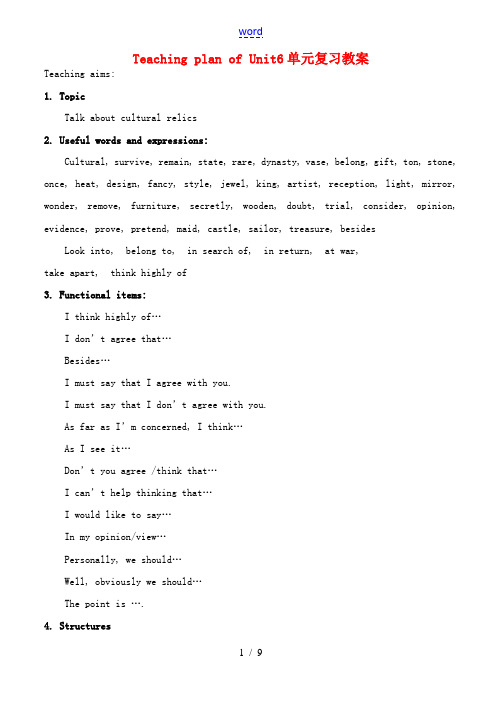
Teaching plan of Unit6单元复习教案Teaching aims:1. TopicTalk about cultural relics2. Useful words and expressions:Cultural, survive, remain, state, rare, dynasty, vase, belong, gift, ton, stone, once, heat, design, fancy, style, jewel, king, artist, reception, light, mirror, wonder, remove, furniture, secretly, wooden, doubt, trial, consider, opinion, evidence, prove, pretend, maid, castle, sailor, treasure, besides Look into, belong to, in search of, in return, at war,take apart, think highly of3. Functional items:I think highly of…I don’t agree that…Besides…I must say that I agree with you.I must say that I don’t agree with you.As far as I’m concerned, I think…As I see it…Don’t you agree /think that…I can’t help thinking that…I would like to say…In my opinion/view…Personally, we should…Well, obviously we should…The point is ….4. StructuresThe attributive clause with that/ which /who /where/ whenA cultural relic is something that has survived…It is your job to look into any reports of cultural relics that have been found in China.This gift was the AmberRoom, which was given this name because…Later, Catherine II had the AmberRoom… outside St Petersburg where…This was a time when the two countries were at war.Teaching proceduresPeriod 1 (Reading)Step 1. Warming upThe warming-up exercise raises Ss’ awareness that there are some well-known cultural relics both at home and abroad. Ask the Ss to try their best to think of the cultural relics that they know.1. Ss say what they know about cultural relics.2. Teacher may summarize like this:Cultural relics are traces or features surviving from a past age and serving to remind people of them. They represent the culture of a place and some periods of history. Of course, some of them are in danger because they are being destroyed.3. Ask the Ss to give some examples of the cultural relics that are in the need of being protected.Step 2. Pre-reading1. Ss discuss and answer:How would you feel if a cultural relic got lost? Why?If you find a cultural relic, what will you do with it?2. Ss look at the two pictures on page 1-2. Ask them if they know what it is called.Step 3. While-reading1. Ss read and find the answers to the following questions:1)Why is it called the AmberRoom?2)What happened to the AmberRoom?2. Second reading: Ss read again and finish prehending.3. Listening: Ss listen to the passage and get the main idea of each paragraph. Main idea:Paragraph 1. We can know that the AmberRoom has a strange history and know something about its design and building.Paragraph 2. We can know the history of the Amber room and its functions in Russia. Paragraph 3. It tells us that Catherine II had the AmberRoom moved to the palace outside St Petersburg.Paragraph 4. It tells us that the Nazi German army stole the AmberRoom in September, 1941. After that the AmberRoom remains a mystery.Paragraph 5. It tells us that the Russians and Germans have built a new AmberRoom at the summer palace, following the old photos.Step 4. After-reading1. Ss discuss and answer: what they can do to protect our cultural relics.2. DebatingSs divided into two parts and debate.Topic: We should rebuild Yuan Mingyuan.We should not rebuild Yuan Mingyuan.Homework1. Recite the key sentences in the text.2. Retell the text.Period 2.(Language learning and grammar)Step 1. RevisionSs try to retell the text, using their own words.Step 2. Language points1. insist that2. 情态动词+ have done3. be made into4. be at war5. remain6. think highly ofStep 3 Discovering useful words and expressions1. Ss read the passage again and try to find word which means each of the meaning on page3,part 1.2. Teach the Ss how to use the dictionary to learn the usage of the phrase: belong to.Step 4. Grammar: The attributive clause1. Ss read the following sentences and try to find the rules.1)It is your job to look into any reports of cultural relics that have been found in China.2) This gift was the AmberRoom, which was given this name because…Ask the Ss themselves to find the difference between the two sentences.3. Tell Ss the differences between restrictive attributive clause and non- restrictive attributive clause.Step 5. PracticeSs finish exercises 2 and 3 on page 4.Homework1. Ss finish Wb exercise: using works and expressions.2. Ss finish Wb exercise: using structures.3. Ss collect some information of the cultural relics that are in danger. Period 3. SpeakingStep 1. Revision1. Check Ss’ homework.2. Ask the Ss to say something about what they have collect about the cultural relics that are in danger.Step 2. Lead-in1. Ss watch videos about the world cultural relics.2. Ss find some cultural relics that are in danger and discuss what they will do with them.Step 3. Speaking taskT: China has tens of thousands of cultural relics. Perhaps it is not possible or necessary to save all of them. For example, Bejing is famous for its lanes or traditional houses and yards. Some people say that only the best ones should be saved. Others disagree, and say they make the capital a special place. Now, let’s have a discussion about this in two sides:Do you think China should save all of its cultural relics?Step 4. WritingAsk the Ss to write an article of 100-200 words about the whole discussion and express your opinion at the same time.Homework1. Review the attributive clauses.2. Remember the sentences that express one’s idea.Period 4. ReadingStep 1. Pre-readingT: since cultural relics are important and useful, it’s necessary for everyone to protect them. After all, they belong to the whole world. so today, we’ll read a passage that is about a mon person who saves the cultural relics—Big Feng to the rescue. Read the passage for the first time and answer why Big Feng wants to save cultural relics. Step 2. Reading (P44)1. Ss read the passage again and answer the following questions:1). How does he save the cultural relics of his hometown?2). What does “a big heart” mean? In which ways does Feng Jicai show that he hasa big heart?3). Why does he think it is more important to do this than to write his novels?4). It is very time-consuming and expensive for Feng Jicai to take care of cultural relics. Can you think of some other ways to help him with his projects?Step 3. Reading, listening and writing1. Ss read the passage on page 5.2. Play the tape. Ss listen to what three people say they know about the missing AmberRoom. As they listen, pretend that they are judges.3. Ss listen again and take notes. Then fill in the forms on page 5. decide which of the three people they think gave the best evidence.Step 4. speaking and writing1. Discuss which person gave the vest evidence. Use the following expressions:Are you sure he/ she was telling the truth? How do you know that?How can you be sure he/ she was telling the truth?Why/why not?That can’t be true.I (don’t) believe …, because….I (don’t ) agree that…The truth is (not) easy to know.I can be proved.2. write down a short list of reasons for your choice.Period 5. ListeningStep 1. DictationT: we will have a dictation of the following sentences:1. Frederick William I, the king of Prussia could never nave imagined that his greatest gift to the Russian People would have such a strange history.2. Once it is heated, the amber can be made into any shape.3. It was made for the palace of Frederick.4. In 1716, Frederick William I gave it to Peter the Great, as a gift of friendship from the Prussian to the Russian People.5. In return, the Czar gave the King of Prussia 55 of his best soldiers.6. The Amber Room soon became part of the Czar’s Palace in St. Petersburg.7. Later, Catherine II had the AmberRoom moved to the palace outside St Petersburg where she spent her summers.8. This was a time when the two countries were at war.9. There is no doubt that the boxes were then put on a train for Konigsberg, at that time a German city on the Baltic Sea.10. After that, what really happened to the AmberRoom remains a mystery.11. I think highly of those who are searching for the AmberRoom.Step 2. Listening (P41)1. Listen to the tape for the first time to get the main idea.2. Ss listen again and talks about a temple in Egypt, and then answer the questions on page 41.Step 3. Listening task (P44)Ss listen to the tape three times. At first time, try to get the main idea. At second time, try to spell the missing words as you hear them. At the last time, make some notes about I M Pei’s life. After listening, work in pairs. Each pair writes a short dialogue according to the notes.Period 6. WritingStep 1. Pre-writing1. Ask the Ss to read Johann’s letter first.2. Ss choose their writing models.Step 2. While-writing1. Ss collect their ideas for the letter. Write them down in order.2. Ss begin to write their letters.3. Choose some letters to show in the class.Step 3. Writing task (P46-47)1. Ss choose one cultural relic in their hometown that they think is worth saving. Write a letter to all the students of their school to encourage them to help save the cultural relic. They can use the model on page 46 as a guide.2. Ss check the answers each other.3. T checks the answers in class.Step 4. Project (P47)Ss finish the project as the following steps:1. Gettogether with three of your classmates and share your letters from the writing task with one another. Read each letter aloud.2. Know take the best ideas from each letter and make an even better plan to protecta cultural relic in your hometown. Explain your reasons.3. Organize your plan step by step to get more and more students to join the project.4. Prepare a short speech and have one member of your group tell you r classmates so that we can protect it well.Period sevenTeachers can use this period freely.Suggestion: Teachers can use this period to let Ss sum up what they have learned and explain what Ss couldn’t understand very well in this unit. Teachers can also add more practice in this period to consolidate what the Ss have learned. Finally, ask the Ss to finish checking yourself. It is very important to improve their learning.。
Teaching Plan for Module 6
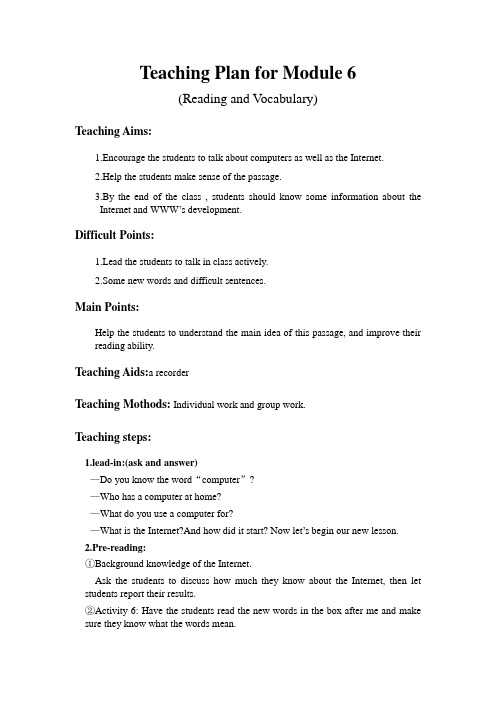
Teaching Plan for Module 6(Reading and V ocabulary)Teaching Aims:1.Encourage the students to talk about computers as well as the Internet.2.Help the students make sense of the passage.3.By the end of the class , students should know some information about theInternet and WWW’s development.Difficult Points:1.Lead the students to talk in class actively.2.Some new words and difficult sentences.Main Points:Help the students to understand the main idea of this passage, and improve their reading ability.Teaching Aids:a recorderTeaching Mothods: Individual work and group work.Teaching steps:1.lead-in:(ask and answer)—Do you know the word“computer”?—Who has a computer at home?—What do you use a computer for?—What is the Internet?And how did it start? Now let’s begin our new lesson.2.Pre-reading:①Background knowledge of the Internet.Ask the students to discuss how much they know about the Internet, then let students report their results.②Activity 6: Have the students read the new words in the box after me and make sure they know what the words mean.3.While-reading:①Scanning:⑴First ask the students to look througn the four questions in activity 1 on page 52 quickly and try to understand them, then read the passage and find out the answers, next check the answers.⑵Ask the students to read again, and summarise the main idea of each paragraph. Paragraph 1Paragraph 2Paragraph 3Paragraph 4Paragraph 5Paragraph 6②Careful Reading:⑴First read the sentences in activity 3 on page 53 ,then decide if they’re true or false.⑵Activity 4:work in groups to find out these sentences and discuss andchoose the best answers.⑶Have the students read the passage again to find the relatedinformation to the following years and complete the table.(work in groups)19691984198919914.Post-reaing:①Retell the passage: Teacher leads the whole class to doing this together as a sample.②Discussion (choose one to practice)⑴Advantages and disadvantages of the Internet⑵Imagine the future life with computers and Internet③Listen to the recorder, then read the whole passage by themselves.Students’Work (一) Blackboard Design(二)The main idea of each paragraph:Paragraph 1Paragraph 2Paragraph 3Paragraph 4Paragraph 5Paragraph 6(三)According to the key words to retell the passage:the Internet 1)the biggest source of information2)accessible through a computer3)first used by armies(in 1969) then…universities(in 1984) now…everyonethe World Wide Web 1)invented by Tim Berners-Lee2)a computer network3)allow computer users to access information …4)web traffic________ increasingnow: _______________web trafficby 2020: ____________The networkDevelopmentInfluence in 1969: ________________________ in 1984: ________________________ in 1989: ________________________ in 1991: ________________________。
小学英语外研新标准二年级上册Module6TeachingplanforU1M6G2
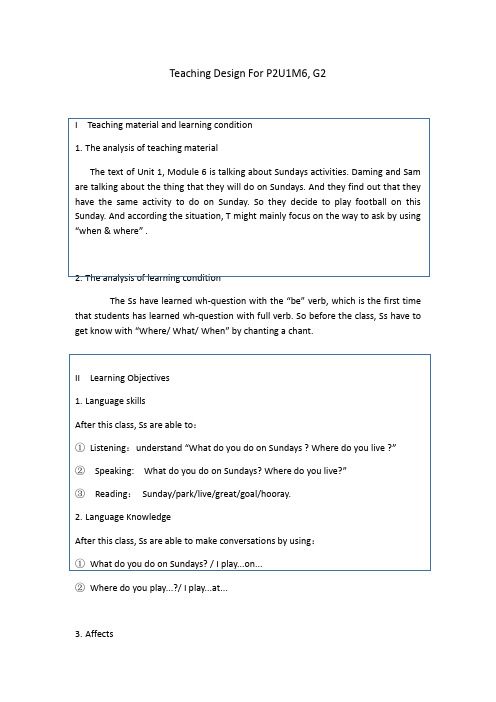
Teaching Design For P2U1M6, G2I Teaching material and learning condition1.The analysis of teaching materialThe text of Unit 1, Module 6 is talking about Sundays activities. Daming and Sam are talking about the thing that they will do on Sundays. And they find out that they have the same activity to do on Sunday. So they decide to play football on this Sunday. And according the situation, T might mainly focus on the way to ask by using “when & where” .2.The analysis of learning conditionThe Ss have learned wh-question with the “be” verb, which is the first time that students has learned wh-question with full verb. So before the class, Ss have to get know with “Where/ What/ When” by chanting a chant.II Learning Objectivesnguage skillsAfter this class, Ss are able to:①Listening:understand “What do you do on Sundays ? Where do you live ?”②Speaking: What do you do on Sundays? Where do you live?”③Reading:Sunday/park/live/great/goal/hooray.nguage KnowledgeAfter this class, Ss are able to make conversations by using:①What do you do on Sundays? / I play...on...②Where do you play...?/ I play...at...3.Affects1.Ss are willing to join the English games, and they are willing to makeconversations by using English.2.Contribute their reverse thinking way by providing answers to fill theWh-question.III Language focuses1.Key points:①What do you do on Sundays?②Where do you play football?2.Difficult points:Match the different Wh-questions with the correct answers.VI Teaching procedures。
八年级英语 Teaching Plan for Unit One of Module 6 Natural elements
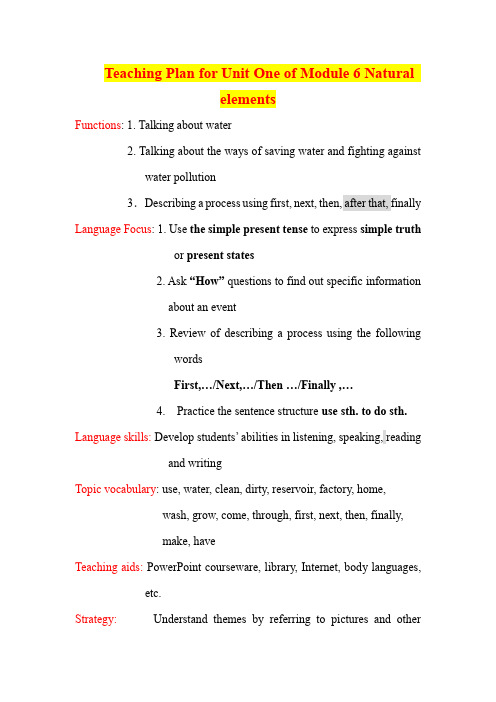
Teaching Plan for Unit One of Module 6 NaturalelementsFunctions: 1. Talking about water2. Talking about the ways of saving water and fighting againstwater pollution3.Describing a process using first, next, then, after that, finally Language Focus: 1. Use the simple present tense to express simple truthor present states2. Ask “How” questions to find out specific informationabout an event3. Review of describing a process using the followingwordsFirst,…/Next,…/Then …/Finally ,…4. Practice the sentence structure use sth. to do sth. Language skills: Develop students’ abilities in listening, speaking, readingand writingTopic vocabulary: use, water, clean, dirty, reservoir, factory, home,wash, grow, come, through, first, next, then, finally,make, haveTeaching aids: PowerPoint courseware, library, Internet, body languages, etc.Strategy: Understand themes by referring to pictures and otherinformationRemember key points by learningMake use of material in the library or on the Internet topromote English language learningTeaching Plan for Unit One (Water)Teaching Plan for the First PeriodI. Greetings.II A guessing game. ( Look and learn )III. Pre-task stageAsk the students to look at the picture presented, and answer the questions to lead them in .T: Now Look at this picture. What is it?Ss: It’s the earth.T: Why do we call it a blue planet?Ss: Because more than 70% of the surface of the earth is covered by sea water.T: We have so much water, but why must we save water?Ss: (With the help of the teacher) The Ocean water is salty , so there isn’t much drinking water.T: In today’s class, let’s talk about WATER. Now, everyone, I told you to go to the library to find books about water and I also told you to search the Internet to get as much information as youcan about water. Have you done that ? Good ! Now show me the books you have found and show me the information you got from Internet ,please ? ( Students show the materials they have found ) Good ! I’m very glad you can use the material in the library or on the Internet to improve your English.IV. Task-cycle1. Learn Look and sayT:How many forms does water have?Ss: Three.T: What are they?Ss: Liquid, solid and gas. (With the help of the teacher) So for liquid we have water and rain and for solid we have ice and snow.T: What about gas?Ss: We have air ,clouds , fog and vapor.T: Yes. If we heat water to a high temperature, water will become vapor. Where can we see water, then? Where does water come from?Ss: We can see water in the sea, in rivers, in streams and lakes. 2. Pair work, thinking of ways we can use water. ( About you)T :Let’s have pair work, talking about ways we can use water at home and at work.Practice the patterns:S1: How do we use water at home?S2: We use water to …S1: How do we use water at work?S2: We use water to …At work, we use water…T: Now let’s share pair work. Please look at the pictures and describe them using the pattern How do we use water at home? We use water to …T: What else can we get from water ?Please look at these pictures and try to find out the answers.Ss : ( With the help of the teacher ) we can get BEAUTY and PLEASURE from water .T: You see , water is so useful in our daily life.IV.While-task stage :1.Listen to the recording of Look and read and think aboutthe questions below.2.Students ask each other questions freely about the text.( Think and write )1)Where do we use water?We use water in our homes and factories.2)Are there any big rivers in Garden City?No, there aren’t .3)Where does most of Garden City’s water come from?It comes from other places.4)How does the water come to Garden City?First , it comes through very long ,wide pipes.5)Where does the water go next?Next, it goes into reservoirs in Garden City.6)Where does the water become clean?It becomes clean in a special factory .VI.Post-task stage1. Group discussion again to suggest possible ways of saving water and fighting against pollution. Start the discussion with a picture. ( a crying face with one drop of tear in the eye ) T: What can you see in this picture?Ss: We see a crying face / We see someone crying .T: Why is she crying ?Ss: ( With the help of the teacher ) Because she’s thirsty ,but she has no water to drink . The plants and the flowersare thirsty and the earth is thirsty, too . Everybody isthirsty.T: What else does it show usSs: And it also shows that if we don’t save water the lastdrop of water could only be a drop of tear in human’seye.T: ( Drawing a conclusion ) So water is a scarce resource.Every drop counts ! And we can’t live without water. But water problem has become a global problem. How do we save water ? How should we fight against water pollution? Now please have a group discussion, talking about the two questions.1). How should we save water?2). What must we do to fight against water pollution?2. Describe the pictures using the the patterns First,…/Next,…/Then…/Finally,… ( Target 1)Ask students to describe the pictures , using the given words.First,we use the water to take a bath . Next ,wash clothes with the water . Then clean the flat with it. Finally flush down our toilets with the same water.T : This is an example of how we can reuse water . Let’s do the recycling together . Just do it!3. Look at these pictures and listen to the recording ( advertisements )Ask students to look at the pictures and listen to the recording of the advertisements about water. In this way they learn to make advertisements in English.3.Make advertisements.Students follow the format/ idea to make a advertisements with this message to save waterT:Now I’d like your to work in groups. Please follow this format/ idea to make advertisements, trying to tell people the importance of saving water and the seriousness of pollution. The group leader is going to put up the best advertisement from your group on the board. Let’s see which group will get the first prize, and which second. Try your best!VII.Assignment:Ask students to send the advertisements they have made tothe newspaper to have them published.T: Now your homework for today: Since you’ve made somany wonderful advertisements about water in today’sclass , why not send them to Shenzhen Daily to have thempublished? Wish you success! Goodbye !注:Target 1 是在Post-task stage阶段进行操练的;Target 2是在Practice阶段进行操练的;Target 3是在Post-task stage阶段进行操练的。
Teaching Plan for Module 6
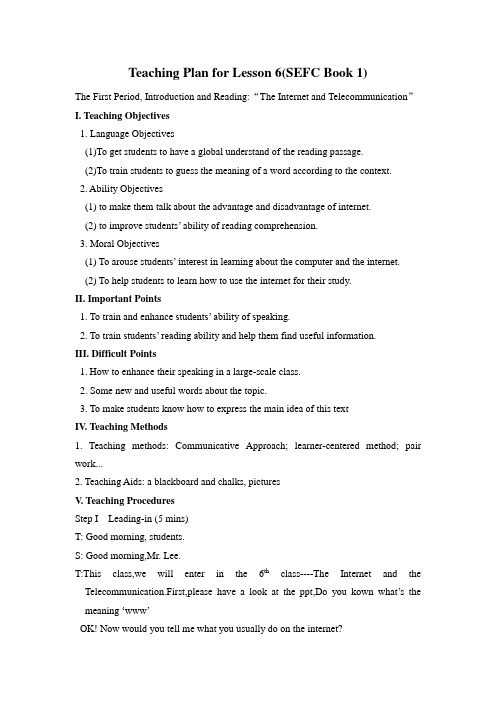
Teaching Plan for Lesson 6(SEFC Book 1)The First Period, Introduction and Reading:“The Internet and Telecommunication”I. Teaching Objectives1. Language Objectives(1)To get students to have a global understand of the reading passage.(2)To train students to guess the meaning of a word according to the context.2. Ability Objectives(1) to make them talk about the advantage and disadvantage of internet.(2) to improve students‟ ability of reading comprehension.3. Moral Objectives(1) To arouse student s‟ interest in learning about the computer and the internet.(2) To help students to learn how to use the internet for their study.II. Important Points1. To train and enhance students‟ ability of speaking.2. To train students‟ reading ability and help t hem find useful information.III. Difficult Points1.How to enhance their speaking in a large-scale class.2. Some new and useful words about the topic.3. To make students know how to express the main idea of this textIV. Teaching Methods1. Teaching methods: Communicative Approach; learner-centered method; pair work...2. Teaching Aids: a blackboard and chalks, picturesV. Teaching ProceduresStep I Leading-in (5 mins)T: Good morning, students.S: Good morning,Mr. Lee.T:This class,we will enter in the 6th class----The Internet and the Telecommunication.First,please have a look at the ppt,Do you kown what‟s the meaning …www‟OK! Now would you tell me what you usually do on the internet?S1: Chat on the internet.T: Yeah...we can chat online with our friends by QQ or MSN, no matter how far away they are from each other.S2:. Search for informationT: Very good! We can use the Internet to get some useful information or the latest news.S3: Do on-line shopping.T: Well done! We can do some shopping on the Internet. Do you usually do some shopping on the Internet? For me, I like to buy something on the Internet, because it is very convenient. Anything else?S4: Yeah... We also can play computer games and so on.T: Well done! We know the computer is playing an important part in our daily life, and the Internet is used in almost every field of our society. OK! Do you know anything about the development of the Internet?S: No...Step II Fast Reading (8 mins)T: Now today we will read the passage about the Internet, and turn to Page52. I will give you 2 minutes to read the passage quickly, and try your best to answer the questions. Now read it by yourself.S: ...(read the passage)T: Well. Have you finished reading it?S: Yes.T: OK. Who‟d like to answer the first question?S: I‟d like to.….T: Yes, right. From the Paragraph1, we know the Internet...The second one?Who want have a try?S:…T: What is the World Wide Web?S:…T: How about the last question?S: I think Tim Berners-Lee invented it.T: Good, right.Step III Careful Reading (20 mins)1.The main idea for each paragraph (8 mins)T: According to the four questions, please think about how many parts the passage can be divided?S: ...T: Good job! The passage can be divided into four parts. The first part is Paragraph1, and the second one is Paragraph2. How about the third one? What is the World Wide Web?S: The World Wide Web is ...T: Which paragraph talks about it?S: The third paragraph.T: Well done! Obviously paragraph3 is the third one. How about the last part?S: The last three paragraphs almost all talk about Tim Berners-Lee.T: Good job! The last part talks about Tim Berners-Lee who invented the world Wide Web, and his another contribution.2.Details of the passage(12 mins)T: Let‟s read the passage carefully. Look at the first paragraph. The Internet is...Do you understand the phrase “consist of ”?S: NO.T: For example, how many students are there in our class?S: 57T: All right! We can say “Our class consists of 57 students ”. Do you know the phrase “be made up of ”?S: Yes.T: We can say “Our class is made up of 5 students”. OK! Now let‟s move to second paragraph, and just now we got to know this paragraph talks about the development of Internet. In order to make you understand the development of the Internet, please read the paragraph carefully. During the time, please pay attention to these aspects: in which year is Internet invented? who invented the network, and the name of the network.S: ...(read the paragraph)T: Now let‟s do it together. At first, in 1969, who invented a way which all computers to “talk” to each other through the telephone?S: DARPA.T: In this period, what name did they call the network of the computers?S: They called it “DARPANET”.T: For fifteen years, could everyone use the system of communication?S: NO! Only the US army could use it.T: How about the 1984? Who invented the network? Now who could use the network in this year? What was the name of the network?S: ...T: We know NSF, the US National Science Foundation, started NSFNET network.Its name is NSFNET. Who also could use the network in this year?S: Universities.T: How about later? Now read paragraph3, 4, and5 carefully, and find out in which year, who invented the World Wide Web? Then think about who could use the internet.S: In 1991, Tim Berners-lee invented the World Wide Web, and everyone can use it.T: Now look at Paragraph3, Line4, at the moment, about...It means the percentage of English is getting small. Now how do you understand the percentage is getting small?S: ...T: Because more and more people in other country use the Internet, the web traffic that is in English is decreased. Just before we know Tim Berners-lee invented the World Wide Web. Now please read the paragraph4 to find out how he invented the World Wide Web.S: ...T: Yeah...He invented it using an old television. We know if you want to invented a computer system, you will spend a lot of time and energy in working it out. All right? How did he get the idea?S: ...T: Well done! We know Tim Berners-Lee invented the World Wide Web. How about his another contribution? At first, he made everyone can use the Internet.Secondly, what did he design?S:...T: Yeah... He designed the first “web browser”. Do you know what the “web browser” is?S: ...T: If you surf the Internet, which software will you use? Yeah, it‟s a software which you can use to search for information on the Internet, such as “360 web browser”, “sougou web browser” and so on. Do you get it?S: ...T: OK! Now look at the picture. There are several computers on the picture. If the central one is ours, we can the document from the other computer through the “web browser”. With the development of the web and the Internet, more and more people use the Internet in their daily life. We OK! we know Tim Berners-Lee invented the World Wide Web, and designed the first “web browser”. He made a great contribution to our life. However, do you think he isa rich man? Why?S: ...T: He just works as a lecturer, so I don‟t think he is a rich man. So much for the text. OK! The Internet is playing an important role in our daily life. It changes our life greatly. Now do you think the Internet is a good thing or a bad thing?Next we will talk about the advantages and disadvantages of the Internet.S: ...Step IV. Summary (2 mins)T: In this class we‟ve learned something about the Internet and computers. We know there are millions of pages of information on the Internet, the US army were the first people who used an Internet system, and how the internet developed. We also know that Tim Berners-Lee invented the World Wide Web and so on.Step V.Homework(2 mins)T: After class, please read the passage again and again,and do exercise3 and 4.Look at exercise6, there are a lot of important words.If you don‟t know some words, you look up them in dictionary. Next class we will talk about in details. That‟s all for today. Goodbye, everyone.S: GoodbyeVI. Blackboard Design。
AteachingplanforUnit3,Module6(外研版七年级英语下册教案教学设计)
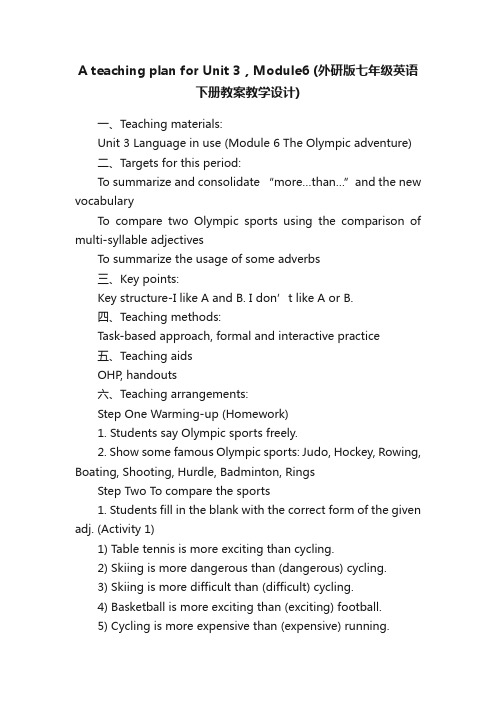
A teaching plan for Unit 3,Module6 (外研版七年级英语下册教案教学设计)一、Teaching materials:Unit 3 Language in use (Module 6 The Olympic adventure)二、Targets for this period:To summarize and consolidate “more…than…”and the new vocabularyTo compare two Olympic sports using the comparison of multi-syllable adjectivesTo summarize the usage of some adverbs三、Key points:Key structure-I like A and B. I don’t like A or B.四、Teaching methods:Task-based approach, formal and interactive practice五、Teaching aidsOHP, handouts六、Teaching arrangements:Step One Warming-up (Homework)1. Students say Olympic sports freely.2. Show some famous Olympic sports: Judo, Hockey, Rowing, Boating, Shooting, Hurdle, Badminton, RingsStep Two To compare the sports1. Students fill in the blank with the correct form of the given adj. (Activity 1)1) Table tennis is more exciting than cycling.2) Skiing is more dangerous than (dangerous) cycling.3) Skiing is more difficult than (difficult) cycling.4) Basketball is more exciting than (exciting) football.5) Cycling is more expensive than (expensive) running.6) Swimming is more popular than (popular) gymnastics.7) Swimming is more relaxing than (relaxing) basketball.8) Running is more boring than (boring) basketball.9) Running is cheaper than (cheap) skiing.10) Basketball is easier than (easy) table tennis.11) Running is safer than (safe) skiing.12) Cycling is more tiring than (tiring) basketball.2. Students complete the dialogue in pairs. (Activity 3 & 4)A: What sports do you like ?B: I like swimming and table tennis.A: Why do you like them?B: I like them because they are more relaxing than running.A: Do you like gymnastics?B: No, I don’t. I don’t like gymnastics or Judo.A: Why?B: Because they are more dangerous than table tennis.Step Three Multiple choice1. Do you think Lesson Two is ______ than Lesson 1?A. easyB. much easierC. more easier2. This cake is ________ than that one.A. more deliciousB. deliciousC. most delicious3. The teacher speaks too ______. I can’t hear _____.A. quick, clearB. more quick, clearC. quickly, clearly4. Their classroom is a little ____ than ours.A. more bigB. biggerC. big5. Which sport is ___, running or skiing?A. more dangerousB. dangerousC. safeStep Four T o fill in the blank with the correct form1. Does your teacher speak slowly (slow) and carefully ( careful)?2. Table tennis is more popular (popular) than football in China.3. He always listens to the teacher quietly (quiet).4. This bike is more expensive (expensive) than the other one.5. Is that book more interesting (interesting) than this one?6. No one gets up earlier (early) than mum.Step Five To complete the sentences.1. They need to learn English quickly (quick).2. The music is loud (loud).3. We play our CDs loudly (loud).4. She plays the piano badly (bad).5. They are working hard (hard) to learn English.6. She speaks English well (good).7. This bicycle is cheap (cheap).8. Running is very easy (easy).9. She gets up early (early).10. She works quickly (quick) and quietly (quiet).11. The teacher speaks slowly (slow) and carefully (careful).12. I don't like to be late (late).Step Six To translate the sentences into English1. 英语比语文难吗?Is English more difficult than Chinese?2. 乒乓球在中国很受欢迎,篮球也是。
- 1、下载文档前请自行甄别文档内容的完整性,平台不提供额外的编辑、内容补充、找答案等附加服务。
- 2、"仅部分预览"的文档,不可在线预览部分如存在完整性等问题,可反馈申请退款(可完整预览的文档不适用该条件!)。
- 3、如文档侵犯您的权益,请联系客服反馈,我们会尽快为您处理(人工客服工作时间:9:00-18:30)。
Module 6 A Teach Plan for Unit 2 Poems
A Few simple Forms of English Poems
Warming and Reading
By Luo Chunyan
Class 12, Senior2
March15, 2011
Teaching goals
Enable the students to master some English expressions and phrases
and to know some knowledge of poems.
Learning ability goals
Enable the students to tell:how many forms of poems and what are their names?
Teaching important and difficult points
Enable the students to understand for details and catch the specific information
as much as possible.
Teaching methods Skimming method. Task-based method
Teaching aids A projector , and a computer
Teaching procedures and ways
Step1 Lead in Using a poem
Roses are red. Violets are blue. My love for you is true.
Step 2 warming up :
1.Brainstorming: Do you remember any little poems or songs you learned when you were a child? These little poems and songs might have been some of the first poetry you learned.
2. Learn what it is rhyme and rhythm.
Twinkle, twinkle, little star, How I wonder what you are.
Up above the world so high,Like a diamond in the sky.
Step3 before reading
1. Read the title of the reading passage and predict what we will read about.
2. How many parts can the text be divided into?
Step 4 reading
Outline of the text
Part 1the purpose of English poems. or introduce the whole page is about
Part2
a general introduction of English poems
Step5 Detailed reading part1
I. There are many reasons why people write poems II. How many forms of poems are introduced and what are their names?
III. What is each poem about?
Poem A:a nursery rhyme that illustrates a father’s love for his baby
Poem B:an amusing nonsense poem which describes images of some ridiculous things
Poem C:about losing a football match and the writer lists a lot of excuses for
their failure
Poem D: a description of a lovely brother
Poem E: a description of hot and boring summer
Poem F: describing how a butterfly rests on a tree
Step6 Further reading
Fill in the chart according to the passage.
Forms of poems Feature
Nursery rhymes Strong rhythm and rhyme, a lot of
repetition, easy to learn and to recite
List poems Repeated phrases and some rhyme
Cinquain Made up of five lines, convey a strong picture in just
a few words
Haiku Give a clear picture and create
a special feeling in just a few words
Tang poems Free form
Step7 Poem admiration
Read Poem H and choose one or more of the feeling below that you think the woman has:
Loneliness joy love trust anger hate sorrow persistence
Homework
Admire WB A, D or E on P 52
1.Which form and give your reasons?
2.Form a cinquain with the following words:
Long ago, but lived once Dinosaurs Remain
only dust and dreams
教学反思:
围绕诗歌这一主题,让学生回顾儿时的诗歌得出诗歌的特征有韵律和节奏,培养学生利用课文标题预测课文内容。
简单了解诗歌的一些基本特征和写作方法,学生积极尝试写简单的诗歌,学会欣赏这些优美的文学作品。
